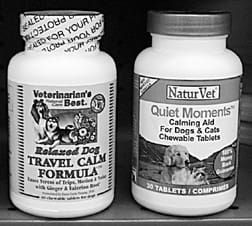Based on the number and variety of herbal “calming formulas” I see in pet stores, there must be a lot of stressed-out pooches out there. Or maybe it’s just that the pet product industry is tapping into the frustrations of consumers who cannot tolerate their high-energy dogs. Regardless, there are more herbal calming formulas for dogs lining pet store shelves than ever before.
But are these products really effective? Are they safe?
The good news is that most of the herbal calming products found at reputable pet supply stores are very safe. Most contain what herbalists like myself consider to be the old calmative standards: valerian root, passionflower, skullcap, chamomile, and other herbs that have been widely used in animals for many years with few, if any, adverse effects.
Some products also contain natural calming agents that are not herbs, such as NaturVet’s “Calming Moments” chewable tablets, a product that combines chamomile and passionflower (Passiflora incarnata) with L-tryptophan (a safe and naturally occurring amino acid).
Common sense dictates that if your dog already receives pharmaceutical drugs that affect central nervous system functions (such as anticonvulsants or antidepressants), or if he is scheduled for any type of anesthesia within the next day or two, herbal calming formulas are best avoided, as they may interact with those types of drugs.
But are they effective?
The question of efficacy is not as easy to answer. Despite the apparent safety of most herbal calming products, questions remain as to whether many of them contain enough active ingredients to actually do the job of bringing about a more restful state. Many contain so many “inactive” ingredients, such as grain byproducts, binders, and flavoring agents, that the active (and usually more expensive) herbal components of the product are present in only minute amounts.
In a way this is good; calmative herbs are much weaker in effect than conventional sedative drugs, and are therefore generally much safer and forgiving to the uninformed user. In fact, in my experiences as a consultant to more than 200 veterinarians over the past 10 years, I have yet to see any serious adverse effects from the use of valerian, skullcap, passionflower, oat flower, or even kava kava in dogs.
None of this is to say that herbal calming formulas are ineffective. To the contrary, even some of the most dilute formulas can be quite effective at taking the edge off exciting events. Some dogs respond quite well to very small doses of calmative herbs.
There are literally hundreds of studies documenting the gentle sedative activities of dozens of calmative herbs. Most of these activities are attributed to plant chemistries that interact with the body to mildly alter various nervous system functions.
However, the efficacy of an herbal calming formula is influenced by several other factors as well. While quality, composition, and concentration of active ingredients all factor into the equation, we also must consider the physical and behavioral nature of the recipient dog, the causes of his anxiety, and the context in which a product is used as important aspects of how an herbal calming formula will act within the body.
Choosing the best product
So, you are probably wondering: Which herb works best? What form of product is best? How much should I give?
While each is a valid question, the question “Which product is most appropriate for my individual?” is the most important. And in finding an answer that works for you and your dog, you should think along four lines:
• Each and every herb has its own range of special attributes and medicinal properties that makes it unique.
Not all calmative herbs are alike. Some, such as chamomile, lemon balm (Melissa officinalis), and valerian are especially well suited to calming a nervous stomach. Skullcap (Scutellaria laterifolia), an herb that many of my veterinarian friends use for treatment of canine epilepsy, is better suited to cases of nervous jitteriness, muscle twitching, or hypersensitivity to touch.
Passionflower can be used in a manner similar to that of skullcap, but it’s better than skullcap when dealing with emotional upset, such as separation anxiety or fear aggression that is associated with jealousy of another animal.
• No single herb will work effectively in each and every animal, because no two dogs are alike. One herb will work well for calming dog “A,” but actually aggravate the emotional condition of dog “B.”
Eastern and Western herbalists regard valerian as a “hot” herb, known to warm the body and “heat the constitution” of the animal. When given to a dog with a hot temperament, or one who is chronically hot, itching for no apparent reason, or displaying a bright fire-red tongue, valerian can actually make the dog even more hot and irritable. Consider this before purchasing a product like Veterinarian’s Best “Travel Calm Formula,” which contains two “hot” herbs: valerian root and ginger. Both of these are great herbs for alleviating travel-induced anxiety and nausea, but they may not be the best choices for hot-natured dogs.
Some formulas balance the heating effects of valerian or other warming herbs by combining them with an assortment of other “cooler” calmatives such as passionflower, oat flower, and skullcap.
• In weighing the choices of which form of product (i.e., tablet, liquid, powder, etc.) to buy, there are two primary considerations. You want a product that is easy to administer, and one that offers optimum availability of active components.
Obviously, if you must chase your dog and force-feed him a vile-tasting product, you will be working against the goal of calming him. And if you are feeding him a product he relishes because of all of the dried meats, grains, and flavoring agents it contains, you might have to feed your dog large amounts before it has any effect.
My preference, of course, is biased by the fact that I own a company that produces a sweet-tasting, alcohol-free tincture blend that I feel offers optimum potency and acceptable palatability in most dogs.
Regardless of which type of product you prefer, follow the manufacturer’s recommendations for how much to administer.
• If it sounds too good to be true, it probably is. Buyer beware.
I strongly believe in herbal medicine, but even I think it’s wise to be a little bit skeptical of extraordinary claims made by manufacturers. And if a calming formula contains an ingredient you don’t recognize, don’t buy it – at least not until you do some research into exactly what the stuff is.
Also With This Article
Click here to view “Calmative Herbs for Canine Panic Attack Occurrences”







I am looking or something natural and save for my dog on the plane. He is 16 pound poodle and I do want to drug him with drugs from the vet.
I would say try buying the actual herbs themselves or a mixture. I personally love this calm down blend I found on Etsy, all organic, no fillers and the best part is they come mixed with passion flower, valerian and chamomile. The dosage is about 500 mg which makes it easy to know whether we give her too much or not. I think your getting more and better quality when you buy the whole herb. You can use them for yourself as well as your pets much more versatile this way!
I forgot where can I purchase this?